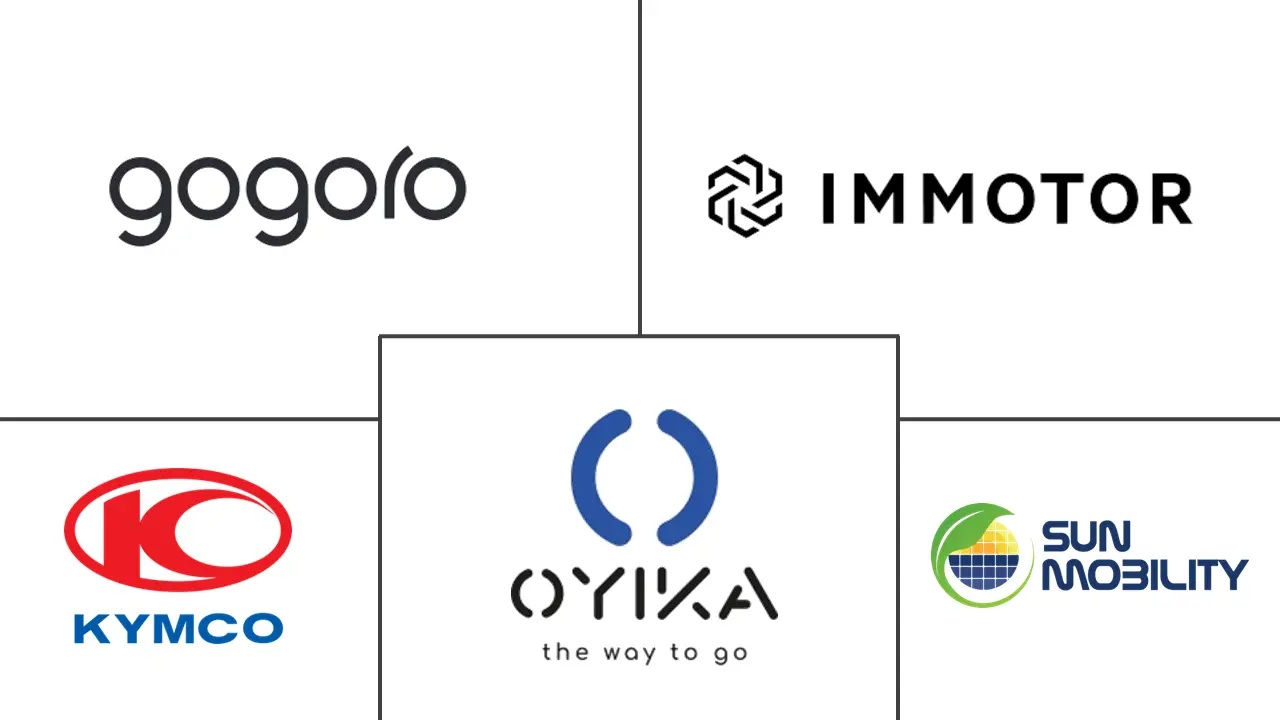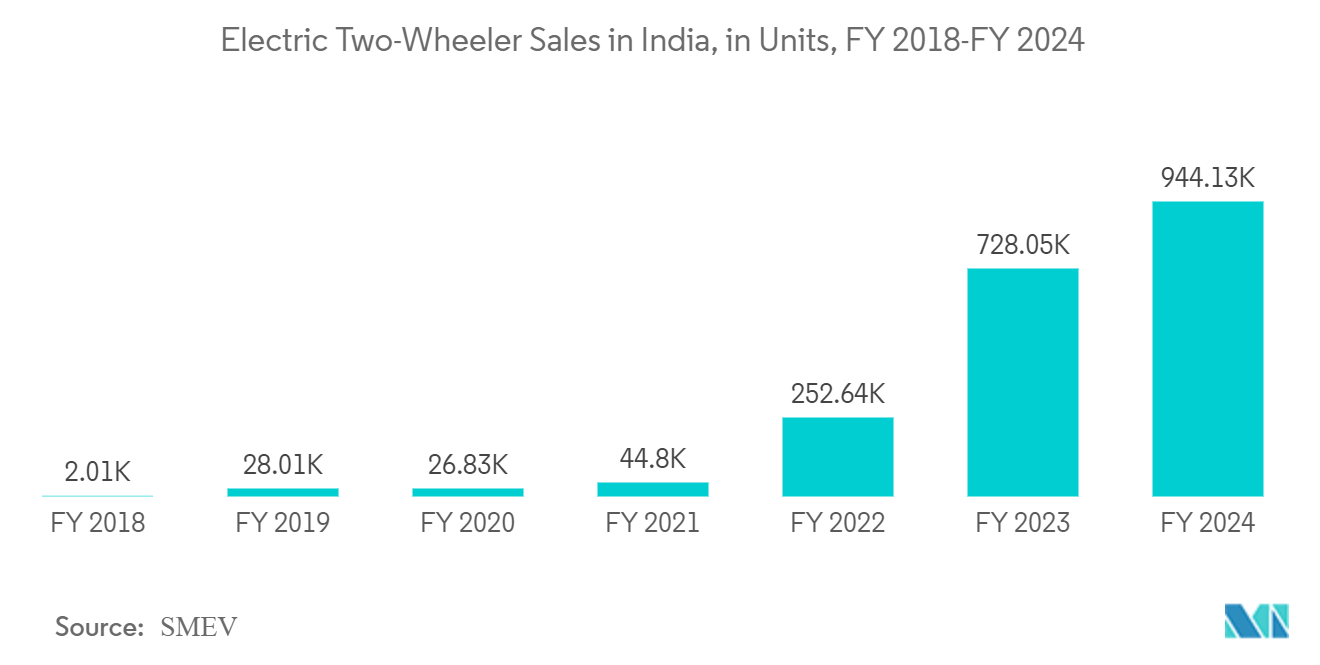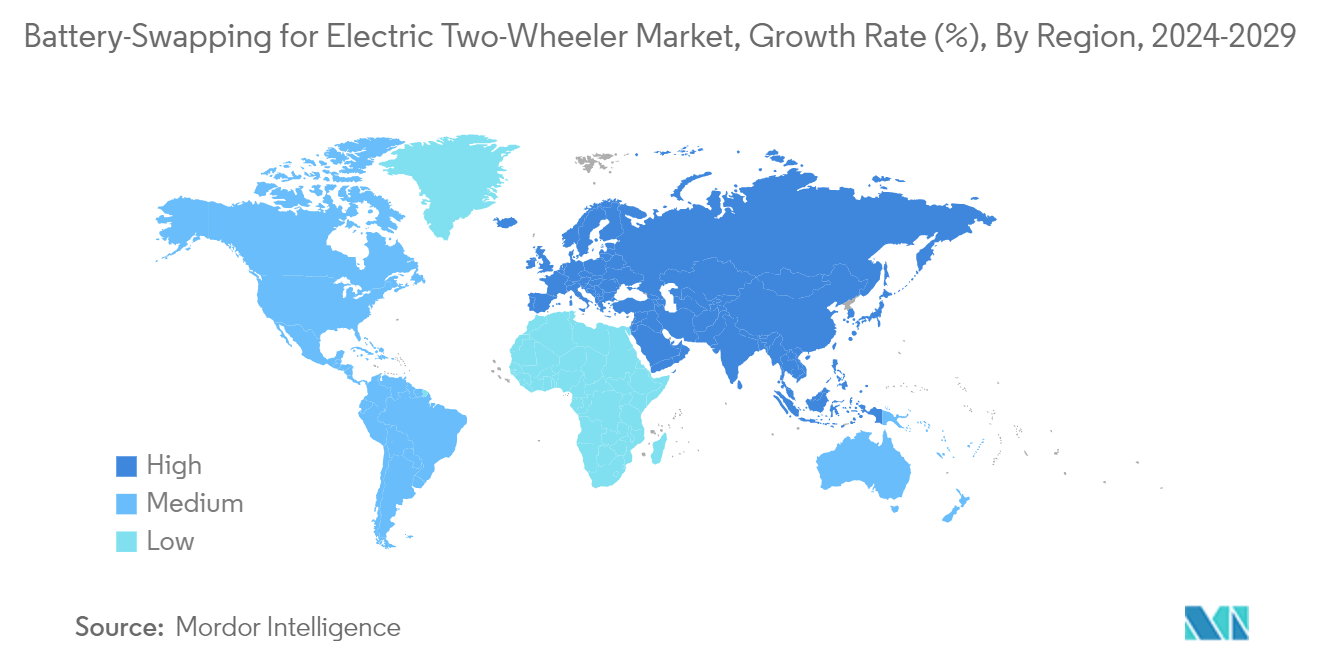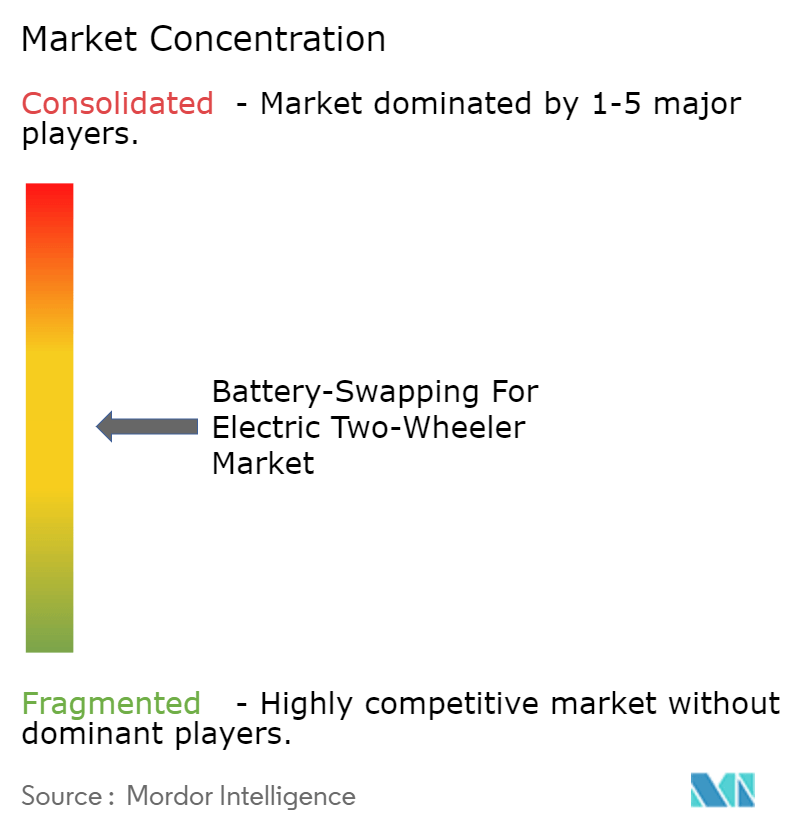Market Overview
The Battery-Swapping For Electric Two-Wheeler Market size is estimated at USD 0.46 billion in 2025, and is expected to reach USD 1.08 billion by 2030, at a CAGR of 18.67% during the forecast period (2025-2030).
In the long run, the global rise of electric two-wheelers, advancements in battery technology, and their increasing use in delivery and ride-hailing services are pivotal drivers for the battery-swapping market. Battery swapping allows consumers to quickly exchange a depleted battery for a fully charged one, often at a reduced cost. This saves money and significantly cuts down on time, a crucial factor for riders in delivery and ride-hailing services who need quick charging solutions.
- In December 2023, Amazon rolled out electric cargo bikes in Croydon, UK, aiming to curb carbon emissions and ease the city's traffic woes. The retail giant has earmarked a substantial investment of GBP 300 million (USD 383.1 million) by 2028, championing the shift to clean energy vehicles for its UK delivery fleet.
As global carbon emissions rise, governments are crafting policies to boost electric two-wheeler adoption. This push is bolstering the battery-swapping market for these vehicles. Recognizing the potential, manufacturers like Yamaha are investing significantly into launching battery-swapping ventures to meet consumer demand. Yet, the industry grapples with challenges: the steep costs of setting up and maintaining battery swapping stations and the absence of standardization among two-wheeler batteries. This lack of uniformity hampers riders' ability to swap batteries at various stations.
- India's Ministry of Road Transport and Highways highlights that Delhi, Uttar Pradesh, and Haryana lead in retail outlets for oil marketing companies (OMC) equipped with battery swapping stations. In 2022, Delhi topped the list with 12 stations, followed by Uttar Pradesh's eight and Haryana's seven.
The battery-swapping market for electric two-wheelers is poised for growth, fueled by the global pivot towards new energy vehicles for daily commutes and cargo transport. Nations like India, Vietnam, and China are at the forefront, with numerous service providers launching battery-swapping initiatives to draw in consumers. Since e-two-wheelers are more affordable than electric passenger cars, they cater well to middle-income consumers, especially in Asia-Pacific.
Key Market Trends
The Lithium-ion Battery Segment Projected to Gain Rapid Traction during the Forecast Period
Ride-hailing and delivery service companies worldwide increasingly opt for electric fleets of scooters and mopeds. This shift is driving the establishment of numerous battery-swapping stations. Delivery riders favor e-scooters and mopeds for their cargo space, aligning with government efforts to decarbonize transportation. Consequently, the rising adoption of e-scooters, particularly in the Asia-Pacific and Europe, is boosting the market demand for battery-swapping stations. These stations predominantly store lithium-ion batteries, known for their superior power and extended distance per charge.
- In 2023, Thailand saw Winnonie, Honda PCX Electric Smart, and H SEM Power Station emerge as the top electric motorcycle battery-swapping services providers. Winnonie operated 103 stations, followed by Honda PCX Electric Smart with 61 and H SEM Power Station with 54.
Furthermore, introducing new electric two-wheeler models equipped with battery-swapping capabilities drives global demand for lithium-ion batteries. Companies like Gogoro are heavily investing in advanced electric two-wheelers featuring lithium-ion battery packs designed for easy swapping at Gogoro's charging stations. As more companies join this ecosystem, the lithium-ion battery segment is poised for significant growth, thanks to its efficiency in battery swapping solutions.
- In May 2024, in India, Bounce Infinity unveiled its latest E1 scooter variant, the Bounce Infinity E1X. This model boasts batteries that can be swapped at various stations nationwide, promoting the adoption of electric two-wheelers with battery-swapping features across the country.
Advancements in battery technology are prompting manufacturers to prioritize lithium-ion packs that minimize downtime and offer faster charging. Given consumers' readiness to invest time for efficient on-the-road charging, the lithium-ion battery market segment is set for rapid growth in the coming years.
Asia-Pacific Expected to Dominate the Electric Two-Wheeler Battery Swapping Market
The Asia-Pacific electric vehicle (EV) battery-swapping market is transitioning from development to expansion. Range anxiety and prolonged charging times hinder the widespread adoption of EVs. Battery swapping addresses range anxiety more efficiently, as each swap is quicker and requires less space than traditional charging stations. Additionally, Battery-as-a-Service is gaining momentum in the regional EV landscape. This model alleviates the steep upfront costs of EVs by decoupling battery ownership from vehicle ownership. Instead of purchasing batteries outright, customers can opt for subscription-based battery-swapping plans tailored to their needs.
- As reported by the Thailand Automotive Institute, sales of new battery electric vehicle motorcycles in Thailand climbed to 2,253 units in January 2024, up from 1,847 units in December 2023, marking a 21.9% month-on-month growth.
Governments across the Asia-Pacific are endorsing battery swapping and actively testing the feasibility of swappable batteries. While national efforts have predominantly centered on establishing a vast network of electric vehicle charging stations, there's been a noticeable lag in developing battery-swapping infrastructure. The successful piloting of battery-swapping solutions now paves the way for a diverse market, fostering an environment where multiple solutions can thrive.
- In April 2022, NITI Aayog unveiled its policy blueprint, charting a course for battery swapping and charging infrastructure along India's highways. This underscored the organization's commitment to accelerating electric vehicle (EV) adoption.
Europe is poised to mirror the Asia-Pacific's embrace of battery swapping. This is driven by the surging demand for electric two-wheelers in cargo, logistics, and delivery sectors, bolstered by a rising tide of logistics and e-commerce firms in the region.
Competitive Landscape
The electric two-wheeler market for battery swapping is characterized by fragmentation and intense competition, driven by a mix of international and domestic players. Key players in this ecosystem include Gogoro Inc., Immotor Technology, Oyika Pte Ltd, Kwang Yang Motor Co. Ltd, Sun Mobility, Greenpack GmbH, Bounce Infinity, Battery Smart, Spiro, Selex Motors, and Swobbee GmbH, among others. These companies invest significantly in installing battery swapping stations for two-wheelers, aiming to bolster their brand presence and offer customers cost-effective solutions for recharging their two-wheeler batteries.
- In January 2024, Gogoro partnered with Copec, targeting market penetration in Chile and Colombia by Q2 2024. This collaboration focuses on expanding battery swapping and two-wheeler operations in these nations. Copec set to establish two battery-swapping stations for Gogoro's intelligent electric scooters in Santiago and Bogota.
- In December 2023, Yamaha unveiled Enyring, a European venture poised to deliver subscription-based battery-swapping services. While headquartered in Germany, Enyring's operations are slated to kick off in 2025, with plans for an additional base in the Netherlands.
The market anticipates the entry of new players, challenging established ones. Many electric two-wheeler manufacturers are keen on operating battery-swapping stations, recognizing their potential for generating recurring revenue.
Major Players
-
Gogoro Inc.
-
Immotor Technology
-
Oyika Pte. Ltd.
-
Kwang Yang Motor Co., Ltd.
-
Sun Mobility
- *Disclaimer: Major Players sorted in no particular order
Recent Developments
- May 2024: Battery Smart, a prominent player in India's battery-swapping service sector, has inaugurated its 1000th swap station in Delhi, catering to electric two-wheelers and three-wheelers. By May 2024, the company had established a significant footprint in over 30 Indian cities, spanning states like Karnataka, Rajasthan, Telangana, and Haryana. Looking ahead, Battery Smart is set on broadening its reach to encompass all major Indian cities, aligning with the government's decarbonization initiatives.
- May 2024: Gogoro has partnered with Nebula Energy to introduce its battery-swapping service in Nepal. This move coincides with the debut of its flagship smart scooter model, the GX250, targeting B2B consumers. Gogoro is eyeing a rollout of its services to retail consumers by the close of 2024. Additionally, the company envisions setting up battery swapping stations at intervals of every 2-3 km throughout Kathmandu in the long run.
- March 2024: Through its venture Kooroo, LG Energy Solution is set to introduce a battery-swapping station business in South Korea. This initiative aims to boost the nation's adoption of two-wheeler EVs. The company plans to implement a monthly subscription model, enabling riders to easily swap their depleted batteries for fully charged ones at any of its stations. This launch is mainly targeted at promoting electric two-wheelers among delivery service firms in South Korea.
Scope of the Report
Battery swapping for electric two-wheelers is a technology that allows the replacement of a discharged battery pack with a fully charged pack without the need to wait, as in the case of charging stations. The process of battery swapping is comparatively advantageous for consumers since it is less time-consuming and also attracts a lower price compared to replacing a battery.
The battery-swapping for electric two-wheelers market is segmented by service type, battery type, station type, battery capacity, two-wheeler type, and geography. By service type, the market is segmented into pay-per-use model and subscription model. By battery type, the market is segmented into lithium-ion batteries and lead-acid batteries. By station type, the market is segmented into manual and automated. By battery capacity, the market is segmented into up to 1.5 kWh, 1.6 to 3 kWh, and more than 3 kWh. By two-wheeler type, the market is segmented into e-scooters/mopeds and e-motorcycles. By geography, the market is segmented into North America, Europe, Asia-Pacific, and Rest of the World.
The report offers market sizes and forecasts for battery swapping in value (USD) for all the above segments.
| By Service Type | Pay-Per-Use Model | ||
| Subscription Model | |||
| By Battery Type | Lithium-ion Battery | ||
| Lead-acid Battery | |||
| By Station Type | Manual | ||
| Automated | |||
| By Battery Capacity | Up to 1.5 kWh | ||
| 1.6 to 3 kWh | |||
| More than 3 kWh | |||
| By Two-Wheeler Type | E-Scooters/Mopeds | ||
| E-Motorcycles | |||
| By Geography | North America | United States | |
| Canada | |||
| Rest of North America | |||
| Europe | Germany | ||
| United Kingdom | |||
| France | |||
| Italy | |||
| Spain | |||
| Rest of Europe | |||
| Asia-Pacific | China | ||
| India | |||
| Japan | |||
| South Korea | |||
| Rest of Asia-Pacific | |||
| Rest of the World | South America | ||
| Middle East and Africa | |||
Battery-Swapping for Electric Two-Wheeler Market Research FAQs
How big is the Battery-Swapping For Electric Two-Wheeler Market?
The Battery-Swapping For Electric Two-Wheeler Market size is expected to reach USD 0.46 billion in 2025 and grow at a CAGR of 18.67% to reach USD 1.08 billion by 2030.
What is the current Battery-Swapping For Electric Two-Wheeler Market size?
In 2025, the Battery-Swapping For Electric Two-Wheeler Market size is expected to reach USD 0.46 billion.
Who are the key players in Battery-Swapping For Electric Two-Wheeler Market?
Gogoro Inc., Immotor Technology, Oyika Pte. Ltd., Kwang Yang Motor Co., Ltd. and Sun Mobility are the major companies operating in the Battery-Swapping For Electric Two-Wheeler Market.
Which is the fastest growing region in Battery-Swapping For Electric Two-Wheeler Market?
Asia-Pacific is estimated to grow at the highest CAGR over the forecast period (2025-2030).
Which region has the biggest share in Battery-Swapping For Electric Two-Wheeler Market?
In 2025, the Asia-Pacific accounts for the largest market share in Battery-Swapping For Electric Two-Wheeler Market.
What years does this Battery-Swapping For Electric Two-Wheeler Market cover, and what was the market size in 2024?
In 2024, the Battery-Swapping For Electric Two-Wheeler Market size was estimated at USD 0.37 billion. The report covers the Battery-Swapping For Electric Two-Wheeler Market historical market size for years: 2019, 2020, 2021, 2022, 2023 and 2024. The report also forecasts the Battery-Swapping For Electric Two-Wheeler Market size for years: 2025, 2026, 2027, 2028, 2029 and 2030.
Our Best Selling Reports
Battery Swapping Industry Report
Statistics for the 2025 Battery-Swapping For Electric Two-Wheeler market share, size and revenue growth rate, created by Mordor Intelligence™ Industry Reports. Battery-Swapping For Electric Two-Wheeler analysis includes a market forecast outlook for 2025 to 2030 and historical overview. Get a sample of this industry analysis as a free report PDF download.







